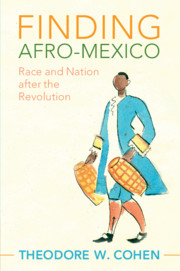Book contents
- Finding Afro-Mexico
- Afro-Latin America
- Finding Afro-Mexico
- Copyright page
- Dedication
- Contents
- Figures and Maps
- Acknowledgments
- Abbreviations
- Introduction
- Part I Making Blackness Mexican, 1810–1940s
- Part II Finding Afro-Mexico, 1940s–2015
- 4 Looking Back to Africa
- 5 Africanizing “La bamba”
- 6 Caribbean Blackness
- 7 The Black Body in Mexico
- Conclusion
- Bibliography
- Index
5 - Africanizing “La bamba”
from Part II - Finding Afro-Mexico, 1940s–2015
Published online by Cambridge University Press: 17 April 2020
- Finding Afro-Mexico
- Afro-Latin America
- Finding Afro-Mexico
- Copyright page
- Dedication
- Contents
- Figures and Maps
- Acknowledgments
- Abbreviations
- Introduction
- Part I Making Blackness Mexican, 1810–1940s
- Part II Finding Afro-Mexico, 1940s–2015
- 4 Looking Back to Africa
- 5 Africanizing “La bamba”
- 6 Caribbean Blackness
- 7 The Black Body in Mexico
- Conclusion
- Bibliography
- Index
Summary
Chapter 5 traces Mexico’s entrance into Afro-diasporic music and dance by exploring how “La bamba” acquired an African heritage. In the decades following the 1910 Revolution, this popular song, and the musical genres affiliated with it, gradually lost its affiliation with indigeneity. In the 1930s and 1940s, composer and ethnomusicologist Gerónimo Baqueiro Foster stated to classify “La bamba” as African-descended and composed Huapangos based on his ethnomusicological research. Mexico’s celebration of black music, including Baqueiro Foster’s arrangement of “La bamba,” set the stage for African American dancer, choreographer, and ethnographer Katherine Dunham to situate “La bamba” with the Afro-Caribbean world once she bought the rights to Baqueiro Foster’s composition and used it to choreograph the ballet Veracruzana, which her Afro-diasporic dance troupe performed across the world. In tracing this cultural history, this chapter argues that the racialization of “La bamba” was a spatial process: as Mexican, Cuban, and African American intellectuals attached the song to Veracruz, the state most associated with the history of the African slave trade, it also became more African and less indigenous.
Keywords
- Type
- Chapter
- Information
- Finding Afro-MexicoRace and Nation after the Revolution, pp. 154 - 189Publisher: Cambridge University PressPrint publication year: 2020

